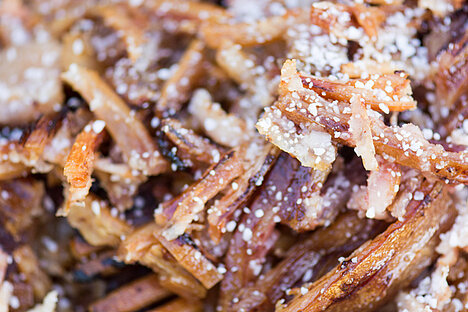Rind

Rind is the name for the skin of pigs, which is often offered as a treat for dogs. But is rind really healthy for your four-legged friend? In this article, you will find out what rind is, what its advantages and disadvantages are and what you should look out for when giving it to your dog.
What is rind?
Rind is the thick, firm layer of skin on pigs, usually attached to some of the underlying fatty tissue. Rind is often smoked, dried or cooked to preserve it and give it more flavor. Rind can be used as a snack or as an ingredient in various dishes.
What are the benefits of rind for dogs?
Rind has several benefits for dogs that you should not ignore. Firstly, pork rind is a natural chew that helps your dog to clean its teeth and strengthen its jaw. Secondly, pork rind contains a lot of protein, which is important for muscle building and regeneration. Pork rind can also be a good source of B vitamins, iron and zinc, which are important for your dog's immune system and metabolism.
What are the disadvantages of pork rind for dogs?
However, pork rind also has some disadvantages for dogs that you should be aware of. For one thing, pork rind is very high in fat, which can lead to obesity, digestive problems or pancreatitis. Secondly, pork rind can contain bacteria or parasites that can harm your dog. Pork rind can also trigger allergies or intolerances if your dog is sensitive to pork.
What should you look out for when giving your dog pork rind?
If you give your dog pork rind, there are a few things you should bear in mind to do him good. Firstly, you should only buy high-quality pork rind that comes from species-appropriate husbandry and does not contain any additives. Secondly, you should wash and heat the rind thoroughly beforehand to kill any germs. You should also cut or break the rind into small pieces to avoid choking or suffocation. Finally, you should only feed the rind in moderation and always pay attention to how your dog reacts to it.
Pork rind is a popular ingredient for dogs that has some advantages, but also some disadvantages. If you treat your dog to a piece of rind from time to time, you should pay attention to the quality, preparation and quantity.
If you notice any signs of hypersensitivity or poisoning in your dog, you should see your vet immediately. We are not a substitute for a vet, but we try to be as accurate as possible. Every dog reacts differently and we recommend you get a second opinion or consult your vet if in doubt.
Stay healthy and take good care of your four-legged friend!😊